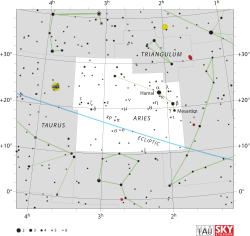HD 15524
| HD 15524 | |
 | |
| Observationsdata Epok: J2000.0 | |
|---|---|
| Stjärnbild | Väduren |
| Rektascension | 02t 30m 32,3544 s[1] |
| Deklination | +25° 14′ 06,107 ″[1] |
| Skenbar magnitud () | +5,90 (V)[2] (5,97 / 10,4)[3] |
| Stjärntyp | |
| Spektraltyp | F6 IV[4] eller F4 V[5] |
| B–V | +0,412 ± 0,006[6] |
| Astrometri | |
| Radialhastighet () | -9,60 ± 1,5[7] km/s |
| Egenrörelse (µ) | RA: +62,407 ± 0,027[1] mas/år Dek.: -75,827 ± 0,026[1] mas/år |
| Parallax () | 19,32 ± 0,44[8] |
| Avstånd | 169 ± 4 lå (52 ± 1 pc) |
| Absolut magnitud () | +2,44[6] |
| Detaljer | |
| Massa | 1,31[9] M☉ |
| Radie | 2,41[10] R☉ |
| Luminositet | 10,01[11] L☉ |
| Temperatur | 6 665 ± 227[9] K |
| Metallicitet | +0,11 ± 0,05 (Fe/H) [12] dex |
| Vinkelhastighet | 59,8 ± 3,0[6] km/s |
| Ålder | 1,633[9] miljarder år |
| Andra beteckningar | |
| AKARI-IRC-V1, J0230323+251405BD+24, 358CCDM J02306+2515AFK5, 2171GSC 01770-01527, HIC 11670, HIP 11670, HR 728, IRAS 02276+25002, MASS J02303235+2514062, PPM 4000391, RXS J023032.5+251413, SAO 75407, TD1 1459, TYC 1770-1527-1, uvby98 100015524, WDS J02305+2514A, Gaia DR1 102394906555022976, Gaia DR2 102394910850317952 [13][2] | |
HD 15524 är en vid dubbelstjärna[3] belägen i den norra delen av stjärnbilden Väduren. Den har en kombinerad skenbar magnitud av ca 5,90[2] och är svagt synlig för blotta ögat där ljusföroreningar ej förekommer. Baserat på parallaxmätning inom Hipparcosuppdraget på ca 19,3[8] mas, beräknas den befinna sig på ett avstånd på ca 169 ljusår (ca 52 parsek) från solen. Den rör sig närmare solen med en heliocentrisk radialhastighet på ca -10 km/s.[7]
Egenskaper[redigera | redigera wikitext]
Primärstjärnan HD 15524 A är en gul till vit underjättestjärna[7] av spektralklass F6 IV.[4] Den har en massa som är ca 1,3[9] solmassor, en radie som är ca 2,4[10] solradier och har ca 10 gånger solens utstrålning av energi[11] från dess fotosfär vid en effektiv temperatur av ca 6 700 K.[9] Stjärnan är den troliga källan till röntgenstrålning som kommer från dess koordinater.[14]
Följeslagaren, HD 15524 B, är separerad från primärstjärnan med 12,4 bågsekunder och har en skenbar magnitud på 10,4.[3]
Referenser[redigera | redigera wikitext]
- Den här artikeln är helt eller delvis baserad på material från engelskspråkiga Wikipedia, HD 15524, 11 september 2021.
Noter[redigera | redigera wikitext]
- ^ [a b c d] Brown, A. G. A; et al. (2016). "Gaia Data Release 1. Summary of the astrometric, photometric, and survey properties". Astronomy and Astrophysics. 595. A2. arXiv:1609.04172. Bibcode:2016A&A...595A...2G. doi:10.1051/0004-6361/201629512. S2CID 1828208.
- ^ [a b c] "HD 15524". SIMBAD. Centre de données astronomiques de Strasbourg. Hämtad 2018-02-26.
- ^ [a b c] Eggleton, P. P.; Tokovinin, A. A. (2008). "A catalogue of multiplicity among bright stellar systems". Monthly Notices of the Royal Astronomical Society. 389 (2): 869. arXiv:0806.2878. Bibcode:2008MNRAS.389..869E. doi:10.1111/j.1365-2966.2008.13596.x. S2CID 14878976.
- ^ [a b] Harlan, E. A. (September 1969). "Mk classifications for F and G-type stars". Astronomical Journal. 74: 916. Bibcode:1969AJ.....74..916H. doi:10.1086/110881.
- ^ Abt, H. A (1985). "Visual multiples. VIII - 1000 MK types". Astrophysical Journal Supplement Series. 59: 95. Bibcode:1985ApJS...59...95A. doi:10.1086/191064.
- ^ [a b c] Ammler-von Eiff, Matthias; Reiners, Ansgar (June 2012), "New measurements of rotation and differential rotation in A-F stars: are there two populations of differentially rotating stars?", Astronomy & Astrophysics, 542: A116, arXiv:1204.2459, Bibcode:2012A&A...542A.116A, doi:10.1051/0004-6361/201118724, S2CID 53666672.
- ^ [a b c] Gontcharov, G. A. (November 2006). "Pulkovo Compilation of Radial Velocities for 35 495 Hipparcos stars in a common system". Astronomy Letters. 32 (11): 759–771. arXiv:1606.08053. Bibcode:2006AstL...32..759G. doi:10.1134/S1063773706110065. S2CID 119231169.
- ^ [a b] van Leeuwen, F. (2007). "Validation of the new Hipparcos reduction". Astronomy and Astrophysics. 474 (2): 653–664. arXiv:0708.1752. Bibcode:2007A&A...474..653V. doi:10.1051/0004-6361:20078357. S2CID 18759600.
- ^ [a b c d e] David, Trevor J.; Hillenbrand, Lynne A. (2015), "The Ages of Early-Type Stars: Strömgren Photometric Methods Calibrated, Validated, Tested, and Applied to Hosts and Prospective Hosts of Directly Imaged Exoplanets", The Astrophysical Journal, 804 (2): 146, arXiv:1501.03154, Bibcode:2015ApJ...804..146D, doi:10.1088/0004-637X/804/2/146, S2CID 33401607.
- ^ [a b] https://www.universeguide.com/star/11670/hd15524. Hämtad 2021-09-23.
- ^ [a b] Anderson, E.; Francis, Ch. (2012). "XHIP: An extended hipparcos compilation". Astronomy Letters. 38 (5): 331. arXiv:1108.4971. Bibcode:2012AstL...38..331A. doi:10.1134/S1063773712050015. S2CID 119257644.
- ^ Ramírez, I.; et al. (September 2012), "Lithium Abundances in nearby FGK Dwarf and Subgiant Stars: Internal Destruction, Galactic Chemical Evolution, and Exoplanets", The Astrophysical Journal, 756 (1): 46, arXiv:1207.0499, Bibcode:2012ApJ...756...46R, doi:10.1088/0004-637X/756/1/46, S2CID 119199829.
- ^ HD 15524 (u-strasbg.fr) |Hämtad 2021-09-23.
- ^ Haakonsen, Christian Bernt; Rutledge, Robert E. (September 2009). "XID II: Statistical Cross-Association of ROSAT Bright Source Catalog X-ray Sources with 2MASS Point Source Catalog Near-Infrared Sources". The Astrophysical Journal Supplement. 184 (1): 138–151. arXiv:0910.3229. Bibcode:2009ApJS..184..138H. doi:10.1088/0067-0049/184/1/138. S2CID 119267456.





